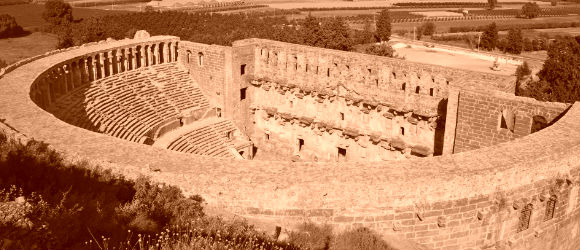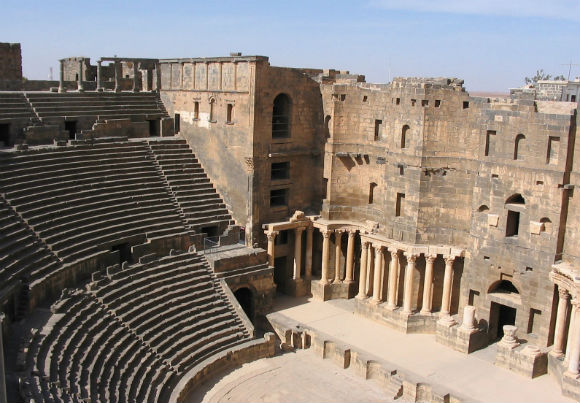Aspendos was an ancient Greco-Roman city in Antalya province of Turkey. It is located 7 kilometres (4.3 mi) northeast of central Serik.
Aspendos was an ancient city in Pamphylia, Asia Minor, located about 40 km east of the modern city of Antalya, Turkey. It was situated on the Eurymedon River about 16 km inland from the Mediterranean Sea; it shared a border with, and was hostile to, Side. According to later tradition, the (originally non-Greek) city was founded around 1000 BC by Greeks who may have come from Argos. The wide range of its coinage throughout the ancient world indicates that, in the 5th century BC, Aspendos had become the most important city in Pamphylia. At that time the Eurymedon River was navigable as far as Aspendos, and the city derived great wealth from a trade in salt, oil, and wool.
Aspendos did not play an important role in antiquity as a political force. Its political history during the colonization period corresponded to the currents of the Pamphylian region. Within this trend, after the colonial period, it remained for a time under Lycian hegemony. In 546 B.C. it came under Persian domination. The face that the city continued to mint coins in its own name, however, indicates that it had a great deal of freedom even under the Persians.
In 467 B.C. the statesman and military commander Cimon, and his fleet of 200 ships, destroyed the Persian navy based at the mouth of the river Eurymedon in a surprise attack. In order to crush to Persian land forces, he tricked the Persians by sending his best fighters to shore wearing the garments of the hostages he had seized earlier. When they saw these men, the Persians thought that they were compatriots freed by the enemy and arranged festivities in celebration. Taking advantage of this, Cimon landed and annihilated the Persians. Aspendos then became a member of the Attic-Delos Maritime league.
The Persians captured the city again in 411 B.C. and used it as a base. In 389 B.C. the commander of Athens, in an effort to regain some of the prestige that city had lost in the Peloponnesian Wars, anchored off the coast of Aspendos in an effort to secure its surrender. Hoping to avoid a new war, the people of Aspendos collected money among themselves and gave it to the commander, entreating him to retreat without causing any damage. Even though he took the money, he had his men trample all the crops in the fields. Enraged, the Aspendians stabbed and killed the Athenian commander in his tent.
When Alexander the Great marched into Aspendos in 333 B.C. after capturing Perge, the citizens sent envoys to him to request that he would not establish that he be given the taxes and horses that they had formerly paid as tribute to the Persian king. After reaching this agreement. Alexander went to Side, leaving a garrison there on the city’s surrender. Going back through Sillyon, he learned that the Aspendians had failed to ratify the agreement their envoys had proposed and were preparing to defend themselves. Alexander marched to the city immediately. When they saw Alexander returning with his troops, the Aspendians, who had retreated to their acropolis, again sent envoys to sue for peace. This time, however, they had to agree to very harsh terms; a Macedonian garrison would remain in the city and 100 gold talents as well as 4.000 horses would be given in tax annually.
In 190 BC the city surrendered to the Romans, who later pillaged it of its artistic treasures. Toward the end of the Roman period the city began a decline that continued throughout Byzantine times.
Aspendos,



This roman theatre is still pretty much how it would have been 2000 years ago. It is still used today for operas and concerts. The ruins around the site are plenty but scattered about and this site as a whole is perhaps not as good as Perge in my opinion. 15TL entrance for adults, kids free.
I'm a classical civilisation student and having the opportunity to visit a site so important to people in the ancient world was great. Aspendos is beautiful and well preserved. It is totally worth going up all the steps to take a picture! Unfortunately there are no people there who speak English that can explain everything to you about the history…
Aspendos is a large Roman site but it only has two preserved ruins – the theater and the aqueduct. Both of these ruins are well preserved, with the theater still hosting various dances and musical performances throughout the year. If you climb to the top of the theater and look out the back, you can still see some of the…
The intact-ness and completeness of the theater takes your breath away. A perfect example of a Roman Theater. If you want to test the acoustics, but don't feel like singing for the whole theater to hear, then have your friends sit somewhere away from you and talk into the curved stone part underneath any bench. They can hear you perfectly….
lovely place very big an nice day out to go and relax have a look around was great
AS other reviewers have said, close enough for a day trip. The theater is built on arches, indicating that it is Roman. Look for the Roman concrete blocks in the towers off the upper level and remember that making concrete was a technology lost for a thousand years after the collapse of the Roman empire.
The state of preservation is amazing and they still hold concerts and event here today. Terrific acoustics.